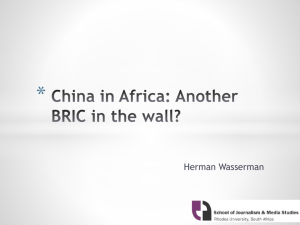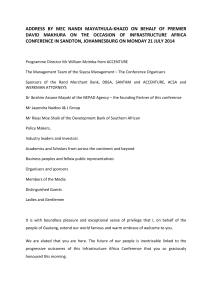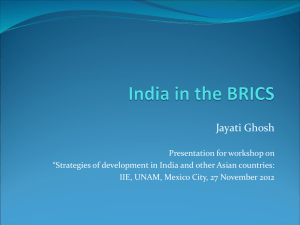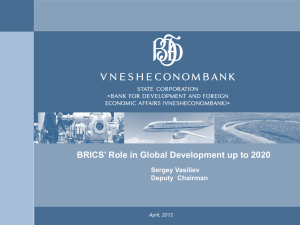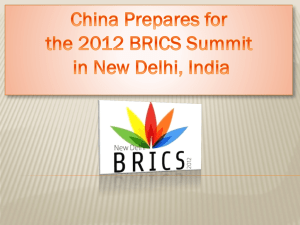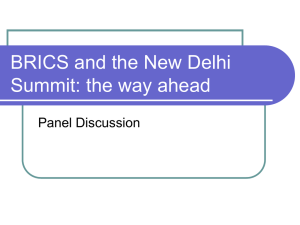The Brics' role in the global economy
advertisement
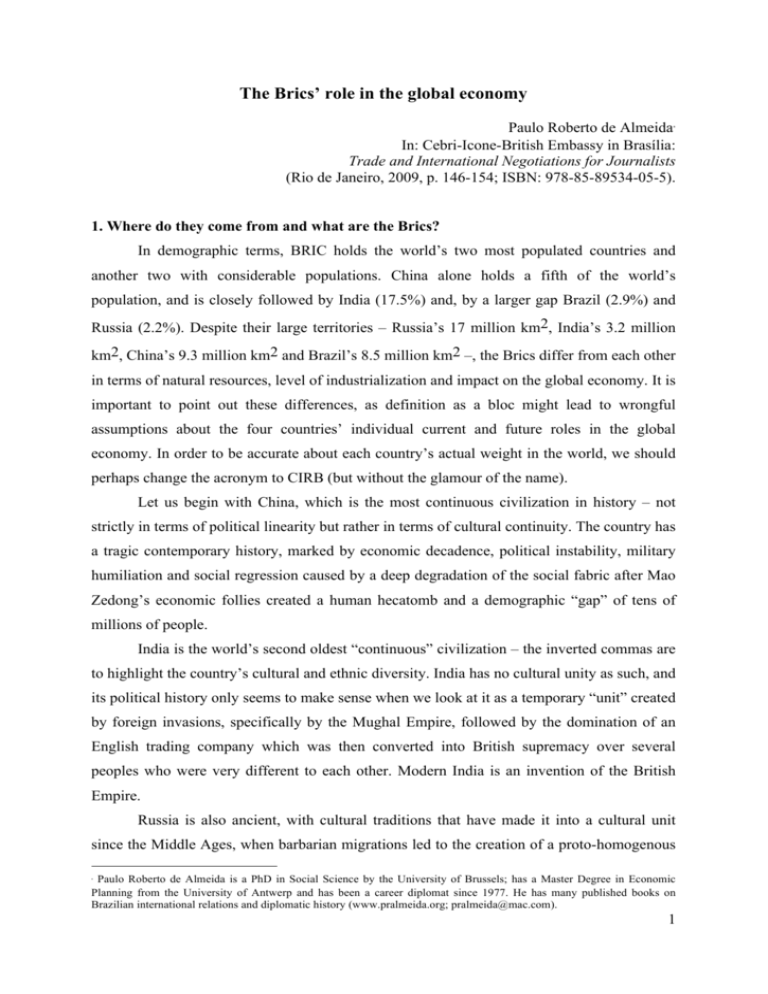
The Brics’ role in the global economy Paulo Roberto de Almeida In: Cebri-Icone-British Embassy in Brasília: Trade and International Negotiations for Journalists (Rio de Janeiro, 2009, p. 146-154; ISBN: 978-85-89534-05-5). ∗ 1. Where do they come from and what are the Brics? In demographic terms, BRIC holds the world’s two most populated countries and another two with considerable populations. China alone holds a fifth of the world’s population, and is closely followed by India (17.5%) and, by a larger gap Brazil (2.9%) and Russia (2.2%). Despite their large territories – Russia’s 17 million km2, India’s 3.2 million km2, China’s 9.3 million km2 and Brazil’s 8.5 million km2 –, the Brics differ from each other in terms of natural resources, level of industrialization and impact on the global economy. It is important to point out these differences, as definition as a bloc might lead to wrongful assumptions about the four countries’ individual current and future roles in the global economy. In order to be accurate about each country’s actual weight in the world, we should perhaps change the acronym to CIRB (but without the glamour of the name). Let us begin with China, which is the most continuous civilization in history – not strictly in terms of political linearity but rather in terms of cultural continuity. The country has a tragic contemporary history, marked by economic decadence, political instability, military humiliation and social regression caused by a deep degradation of the social fabric after Mao Zedong’s economic follies created a human hecatomb and a demographic “gap” of tens of millions of people. India is the world’s second oldest “continuous” civilization – the inverted commas are to highlight the country’s cultural and ethnic diversity. India has no cultural unity as such, and its political history only seems to make sense when we look at it as a temporary “unit” created by foreign invasions, specifically by the Mughal Empire, followed by the domination of an English trading company which was then converted into British supremacy over several peoples who were very different to each other. Modern India is an invention of the British Empire. Russia is also ancient, with cultural traditions that have made it into a cultural unit since the Middle Ages, when barbarian migrations led to the creation of a proto-homogenous Paulo Roberto de Almeida is a PhD in Social Science by the University of Brussels; has a Master Degree in Economic Planning from the University of Antwerp and has been a career diplomat since 1977. He has many published books on Brazilian international relations and diplomatic history (www.pralmeida.org; pralmeida@mac.com). ∗ 1 Slavic proto-nation. This took place when Peter the Great subjugated feudal authority and consolidated his power over an undefined territory, drawn together under an insipient State based on imperial absolutism. This State expanded between the 18th and the 20th centuries, when it reached the height of its territorial size and power under the rule of the Soviet Czars. The Soviet Empire was a paradox in Russia’s trajectory. Despite achieving the national security it had always aspired to, it also created an irrational economic system that ended up causing the State’s structural crisis and thunderous downfall. Finally there is Brazil, a typical colonial creation, with the slow implementation of a successful economy contrasting with a more precocious State building. Brazil’s unified State came before the consolidation of an integrated economy. The State was the inducer of an industrial economy, which is quite modern compared with other peripheral countries. Brazil is happy with its geographical division and regional relations. This context of regional peace – at least since the end of the Paraguayan War (1865-1870) – and of a lack of real external threats are defining factors behind Brazil’s geopolitical singularity and should be considered as a positive asset for regional and international inclusion. The Brics’ itinerary over the past two centuries has been uneven and at times divergent. Reciprocal relations over the last half-century have been marginal, with the possible exception of the former Soviet Union (USSR) and China during the early implementation of socialism in the latter. Although the path of the Brics’ interaction with the global economy has been erratic, there has been some convergence over the past two decades complemented by incremental reciprocal integration. The Brics’ individual participation in global capital, trade, investment and technology flows retreated over the two centuries between the First Industrial Revolution and the eighth decade of the 20th century. As of the 1980’s, the four countries resumed a more intense interaction with the global economy. This retreat was born both by the Brics’ own decisions – socialist revolutions in Russia and China, the adoption of state planning in India – and was involuntary, as in the case of Brazil where crises prompted nationalizing introversion (the 1929 crisis and the depression of the 1930’s as stimuli for national industrialization). During the construction of a post-Second World War world economic order, both the USSR and China excluded themselves from the global capitalist system’s institutions – the International Monetary Fund (IMF), the International Bank for Reconstruction and Development (IBRD) and the General Agreement on Tariffs and Trade (GATT). Brazil and India adhered to these bodies in a reluctant and marginal manner. Although Brazil has been active in these bodies of capitalist interdependence, its participation has been more as a client 2 than as an important party in decision-making processes, which until a short while ago were far beyond its capabilities. More than any other BRIC member, Brazil has kept a market structure and an economic management model in line with capitalism’s formal pattern of economic organization. India, the other BRIC member that remained capitalist during the Cold War, was much more nationalizing, bureaucratic and backward than Brazil. India’s recent modernizing boost has largely come from its economic Diaspora in the US rather than from internal transformations (but there has been liberalization under Manmohan Singh). China was an economic disaster. This is not only due to decadence during the Civil War and the Japanese invasion, but also due to the plans of the Maoist Era (the Great Leap Forward and the Cultural Revolution). Suffice to say that in gross terms, between the end of the 18th century and the 1960’s, China’s GDP fell from nearly one third of the world’s GDP to less than 5%, and only managed to recover in the 2000’s. Regarding Russia, in addition to its reduction after the collapse of the USSR, statistics from the Soviet Era are not reliable enough to establish the development of its performance in the 20th century, when the country underwent huge material and human disasters. The Central Intelligence Agency (CIA) always overestimated the industrial power and technological capacity of this enormous Potemkin village, which lived an institutionalized lie over seven decades. The reincorporation of the Brics’ into the mainstream global economy as of the eighth decade of the 20th century happened differently for each member. Although Brazil was never excluded from the global economy as such, until the mid-80’s almost 95% of domestic supply came from local industry, as a result of strong state protectionism. India took state capitalism even further, which, along with its extensive planning, was responsible for decades of reduced growth and low levels of modernization. It was China, in fact, which sparked the big transformation in the global division of labor by redrawing the global direct investment map via Deng Xiao-Ping’s reforms. Russia reconverted to Mafia-style capitalism in the 1990’s and became more of an energy raw-material supplier than an active player in the global economy. Brazil has become a major supplier of food and mineral commodities; India has consolidated its presence in the information technology sector; and industrial China has become the leading manufacturer of mass consumer products, especially electronic goods. Everyone has benefitted from the Ricardian advantages, with a special emphasis on labor in China’s case, technology in India’s and natural resources in Brazil and Russia’s. And where are the Brics heading over the coming decades? Certainly not to the same destination, even though their trajectories have a common thread of growing and unavoidable adhesion to the global economy. According to a study by Goldman Sachs, this G4 group’s 3 joint GDP will exceed the G7’s current GDP by 2035, and China’s will exceed everyone, individually, by 2040. The factors behind this performance are very diverse: a probable technological “explosion” in China; the continuity of Russia’s extraction activities; and huge competitiveness in Brazilian agriculture and in Indian internet services and information technology – the latter of which is already taking place. Although the Brics’ joint atomic mass might overtake G7, in per capita terms their well-being and productivity indicators will remain below the developed countries’. 2. What is the Brics relationship with the global economy? Economic transformation is the result of a combination of structural and politically based factors. Russia and China sunk in the destructive chaos of their socialist economies through the charismatic force of their original leaders. Despite being efficient when it came to party organization, these leaders – Lenin and Mao – were unable to grasp the way in which a modern market economy works. In Russia’s case, the transition to capitalism has remained erratic, whilst China has seen a combination of political authoritarianism and firm guidance towards a market economy. China is unique in world history in terms of its sustained growth, with structural transformations that have an enormous social impact. In the case of Brazil and India, transformations have been due less to a directed “return to the market” or “revolutions from above” than to the “deep forces” of their semicapitalist regimes, whose creative energy was released by economic opening and trade liberalization. Brazil’s central problem was to break with self-feeding inflation and the pernicious effects of exchange rate pressures. This process was conducted in full, despite the financial turbulence that threatened an adjustment between the second half of the 1990s and the beginning of the 2000s. India, meanwhile, had to lift itself from a Mesozoic state of planned economy and over-zealous protectionism. Although it faced some delays, this process was facilitated by a high-quality economic Diaspora in the main developed economies – a phenomenon that also took place in Chinese history, but with different characteristics. Strictly speaking, China seems to have reproduced – at a higher adaptation pace and with the huge ambition of rapidly recovering from the lost decades of crippling socialism – the Japanese experience of the Meiji Revolution. It has sent its offspring to learn from the scientific and technological leaders of advanced capitalism. Above all, China has focused on the Japanese post WWII miracle, in which the country copied and adapted Western knowhow with extreme care and quality, in order to make the same products with its own designs and brands. China is the only emerging nation among all the Brics that seems destined to 4 convert itself into a dominant economy, as well as a technological and military power. However, the country is still very far from offering its citizens – many of whom are still subjects of an authoritarian regime – the level of individual well-being enjoyed by the populations in advanced capitalist countries. Russia has lost territories with important natural and human resources and therefore does not seem close to recovering the political and strategic relevance enjoyed during the height of its geopolitical expansion at the end of the 1970s. Despite owning a formidable nuclear arsenal and the capacity for some military projection, the country is in no condition to challenge the two global economic giants of the mid-21st century. Russia’s resources are finite and its demography is declining, albeit having a high quality human force. India, for its part, is apt to master, with competence, the electronic services it already offers with expertise. It will, however, have to absorb into the market economy hundreds of millions of rural workers stagnating in an ancestral economy. Brazil has almost a generation ahead of it to benefit from a demographic bonus, namely the best possible relationship between the economically active and dependent strata of people. This opportunity will probably be missed, largely because of the low levels of technical qualification and education among the population, which will reduce productivity gains. These shortcomings should not prevent the Brics from gaining greater relevance, which they will through their heavy demographic weight and growing consumer market, with the possible exception of Russia. But they will be unable to reach the levels of technological excellence of nearly all of the countries of the advanced capitalist world. Once again, the exception should be China, which will reproduce Taiwan and South Korea’s technological performance with surprising rapidity. In the case of liberalizing capital movements and trade policy, Bric approaches tend to vary, although tending towards the adoption of a pattern more propitious to those countries’ international economic integration. This is in contrast to the restrictive policies adopted by all of these countries less than a generation ago. The most important ruptures took place, obviously, with the two socialist giants, as in contrast Brazil and India were on the edges of a capitalism characterized by an overwhelming state presence. These latter two countries were founding members of GATT and were there at the very start of the Bretton Woods institutions, without having to necessarily take on their prescriptions for economic policy. China and Russia joined the IMF and IRBD as soon as they overcame ideological restrictions to these symbols of the capitalist world, but the process was more complicated in the trade sphere. It took 14 years for China to be admitted to GATT, something that took 5 place only just before the Doha Round (2001) began. It still maintained some practices at odds with normal trading relations. Russia, while politically accepted into the G7 and fully recognized as a market economy since the Kananaskis (2002) G7 summit, has been unable to meet the demands required to be accepted into the multilateral trading system. Neither does it appear close to entrance into the Organization for Economic Co-operation and Development (OECD). Its recent resumption of a muscular foreign policy could push it even further from these organizations. Over the decades, Brazil and India have maintained the typical pattern of “developmentalist” policy prescribed by Keynesian economists like Raul Prebisch and Gunnar Myrdal. This meant a lot of monetary profligacy, exchange restrictions, trade protectionism, and discriminatory measures against foreign investments. These policies began to change at the end of the 1980s and the start of the 1990s. The countries still have a defensive trade policy in the industrial area but, thanks to information and communications technologies, India has opened up its service sector, while Brazil has proved more hands-on in combating farm subsidies and protectionism (which should include Brazil’s G20 allies China and India). The monetary, trade and foreign investments policies of the Brics are as varied as their forms of global insertion, but the results are reflected in current accounts. Brazil came out of a quite fragile situation between the second half of the 1990s and the beginning of the 2000s – which prompted it to seek preventive financing through three agreements with the IMF (1998, 2001 and 2002) – into a relatively comfortable international position of foreign reserves higher than foreign debt. With its huge trade surpluses, China is on the way to further record currency reserves, and should remain as a dynamic exporter in the foreseeable future. Russia’s trade surpluses are either growing or comfortable, but its structural position is fragile due to its dependency on oil and gas. India’s deficits, despite rising, are manageable in relation to its also growing economy. All those scenarios should suffer the impact of the international financial crisis started in the U.S., but emerging economies are expected to maintain a higher rate of growth than those of OECD group. 3. What will be Brics’ future impact on the global economy? The justification for the Bric acronym, according to its original proponent, is the extent to which these economies have an impact on the global economy, as well as their capacity to shape the future of other developing nations. Barring Brazil, with very modest 6 growth rates over the last years, the three other Brics have been gaining weight and importance globally and within sectors. In theory, in a few years the Brics will represent a fifth of the global economy and in two decades will overtake the G7. This aggregation of individual volume might make sense in this type of intellectual exercise, in which arithmetic seems to prevail over politics. However, it is unlikely to indicate global economic development trends, as these are caused by technological transformation and capital, scientific and strategic information flows – as shown by the history of capitalism. In fact, given their demographic importance and the growing dissemination of technology and direct investment, we could say that developing countries’ share in global goods and services exports and GDP will certainly rise above current levels. This is an elementary conclusion that adds nothing to the other aspects – especially institutional and political – that interact with the structural forces that shape the global system. Basically, despite the Bric’s decisive economic impact, this feature by itself says nothing about the other factors behind a complex relationship that goes beyond GDP and exports, and into reciprocal interdependency – not between the Brics but between each of them and their various economic partners. From this point of view, the Brics group do not have an economic existence per se and is purely a creation of the “economic spirit”. Despite arguments about the decoupling of the main emerging economies from the G7 and other developed nations’ economic cycles, the truth is that the dominant economies’ impact on Bric is more decisive than normally admitted. It is not only about consumer markets and direct investment sources. The global economy is not just an economic space for the exchange of goods and services, where each nation can have greater or lesser “physical” interaction. It is, essentially, an arena for the exchange of ideas, in which the intellectual domination of the so-called developed Western world looks set to remain throughout the foreseeable future. When we look at the overall picture for the global economy, we reach an inevitable conclusion: the same forces that have transformed the world since the 16th century are still shaping the contemporary world. These forces include not only the flow of goods and services, but forms of economic organization and above all, the production of ideas and concepts to support those physical flows. Therefore, it is inconceivable to consider that developing or emerging nations could be independent from the core of the global economy. The path and economic destination of the Brics and other emerging economies cannot be different from those followed by developed nations. The latter set the basic parameters on 7 which the economy is based. However, this dynamic process is not exclusive to a specific center, but shared by several centers producing and spreading ideas and practical knowledge. The apparently novel concept of Bric is a trouvaille that has occupied journalists’ minds and instigated the imagination of academics in their search for new ideas. This concept seems to induce those concerned with the old hegemony to seek a rupture with and the replacement of an “old system”. It is historically rare to have peaceful attempts to change the balance of world power, as the beneficiaries of the status quo tend to resist the contesters’ demands for a new space in the old order. If these expectations are not met, the new contestants could opt for changing this order by their own initiative – hopefully through peaceful ways, but if necessary, they will try through violence. Once the fascist contesters of the inter-war period were contained, defeated and radically transformed, the geopolitics of world power began, as of 1947, to be dominated by Soviet expansionism without direct confrontations with the US. Conflicts took place often via proxies, with each side advancing and retreating in peripheral arenas where the crucial aspects of the great game were being played. This “Third World War” ended without the conservative hegemon winning a victory; the defeat of the economically weaker side was actually brought about by the implosion of a senile socialism that was incapable of competing in terms of productive efficiency. After the USSR’s spectacular demise and in a moment in which the US emerged as the only superpower, the world seems to be moving towards a transition. This new stage sees the US’ decline and China’s ascendance, the reaffirming of Russia’s strength or the emergence of new players (India, Brazil, the European Union), which could redistribute the cards in new strategic scenarios. Whatever the future of global geopolitics in the 21st century – be it a new Cold War of a “Cold Peace” – it has nothing to do with being a member of a group invented by an economist, even though there might be conflicts generated by some of these members’ candidacy as emerging global powers. The Bric’s situation is accidental and fortuitous, whereas being a global emerging economy is a structural condition that was acquired by a long and slow process of productive and technological qualifications that will naturally convert into military and political power. Bric’s two former socialists have authoritarian characteristics that represent a legacy of centuries of totalitarian states. The other two members have had democratic trajectories with faults in terms of functioning and social justice – and are the market economies closest to capitalist organization patterns. Of all the members, Brazil has the most advanced capitalist structures and the most modern society. It is also the most integrated society in language, 8 cultural, ethnic and possibly religious terms, which in principle enables a more efficient political administration - without institutional ruptures - and more favorable conditions for modernization. Although social democratization can slow growth and adaptation to new environments, it also contributes to greater cohesion around national goals. The main issues dividing the world today are no longer ideological, as they were less than three decades ago, when competing projects were trying to win peoples’ hearts and minds. Neither are they technical, as there seems to be reasonable consensus and collaboration among the world’s researchers and scientists about the challenges of medicine, physics and biology. Today’s main dilemmas are about political priorities and alternative economic measures to be chosen by heads-of-state for solving the age-old problems that afflict mankind: hunger, unemployment, health, education, security and welfare. Experience in the recent past about these choices and attempts to impose them on whole societies in an authoritarian manner, does not reflect well on some of the solutions proposed by radical challengers to the status quo. We do not have to go back to the terrible example of Nazi Germany or militaristic Japan to conclude that emerging powers tend to be hasty competitors ready to use violence if necessary to challenge the power of older hegemons. That History lesson must have been learned, however. Let us hope this time it will be different. [Revised PRA: 29Jan09] 9
